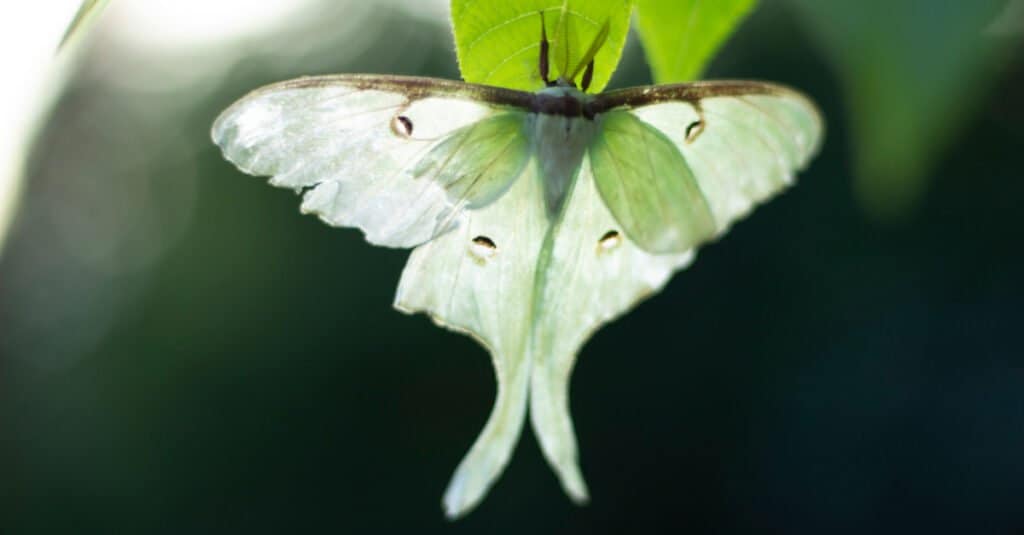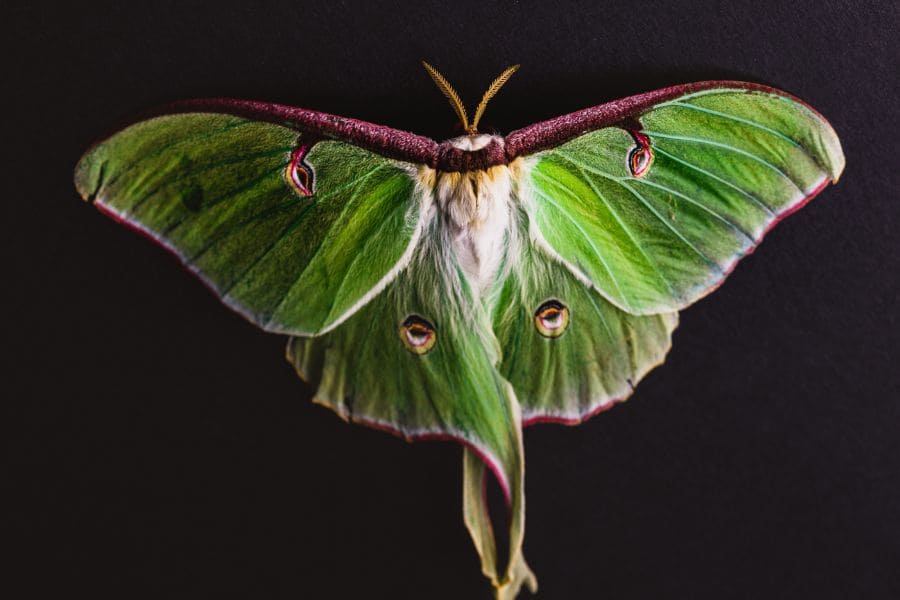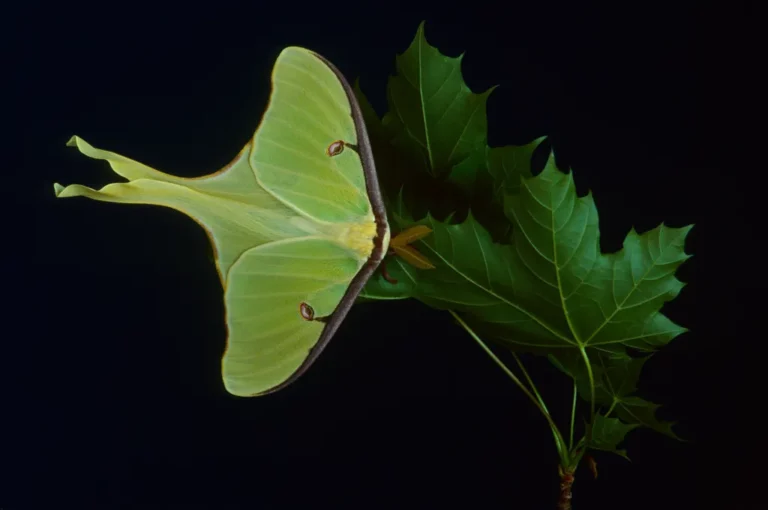Determining if a Luna Moth is dying can be challenging, as they are typically elusive and nocturnal creatures. However, there are several signs that may indicate a Luna Moth is in poor health or nearing the end of its life cycle:
- Tattered wings
- Lethargy or inability to fly
- Discoloration of wings or body
- Shrunken or deflated abdomen
- Reduced responsiveness to touch
- Drooping antennae
- Decreased activity during the daytime
How to identify physical signs of a dying Luna Moth?
Luna Moths are known for their distinctive pale green wings, which are quite delicate.
When the wings appear torn, ragged, or damaged, it’s often a sign of significant wear and tear.
These damages can hinder their ability to fly effectively, making it challenging for them to find food or mates, which is crucial for their survival.
Lethargy and inability to fly:
Healthy Luna Moths are typically active at night when they search for a mate. A dying Luna Moth may become lethargic, unable to fly, or show reluctance to move.
Moreover, their inability to fly can indicate underlying weakness or illness, making it difficult for them to fulfill their reproductive role.
Discoloration of wings or body:

Luna Moths are recognized by their vibrant pale green coloration. Discoloration, such as faded wings or a duller body, is a sign that the moth may be aging or struggling with health issues.
Furthermore, this loss of vibrancy can impact their ability to blend into their natural surroundings, potentially making them more vulnerable to predators.
Shrunken or deflated abdomen:
A healthy Luna Moth typically has a plump and full abdomen, indicating that it has sufficient energy reserves. A shrunken or deflated abdomen is a sign that the moth may be nearing the end of its life cycle.
.As Luna Moths primarily emerge to reproduce, a reduced abdomen size may suggest that they have completed this vital task.
Reduced responsiveness to touch:
Luna Moths are generally sensitive to touch and will respond by moving or fluttering their wings.
However, if a Luna Moth doesn’t respond or reacts weakly to gentle touch, it may indicate that it lacks the energy and vitality to defend itself or seek out a mate.
Drooping antennae:
Luna Moths have long, feathery antennae that play a critical role in detecting pheromones from potential mates.
When their antennae droop or appear limp, it could signify a lack of vitality and diminished ability to communicate with potential partners.
Decreased daytime activity:
Luna Moths are primarily nocturnal creatures and are most active during the night when they search for mates. In addition, if you observe a Luna Moth being inactive during the daytime, it may be indicative of its overall weakness or nearing the end of its life cycle. Reduced daytime activity can also be a protective mechanism to avoid daytime predators.
What is the reason behind the Luna Moth’s short adult lifespan?
The Luna Moth (Actias luna) undergoes a fascinating and well-defined life cycle that includes various stages: egg, larva (caterpillar), pupa (cocoon), and adult moth. Luna Moths have a remarkably short adult lifespan compared to their other life stages, and there are several reasons for this:
Focus on Reproduction: The primary purpose of the Luna Moth’s adult stage is reproduction. Once they emerge from their pupal stage, their sole objective is to find a mate and reproduce.
Moreover, their short adult life is a strategic adaptation that minimizes energy expenditure on activities other than reproduction.
Limited Energy Reserves: Luna Moths do not feed during their adult stage. They rely entirely on the energy reserves built up during their caterpillar stage.
Additionally, these energy reserves are finite and can sustain them for only a short period, typically about a week. As a result, Luna Moths are not equipped for long-term survival as adults.
Avoiding Predation: Luna Moths are vulnerable to predators, especially during their adult stage when they are more visible and active.
Their short adult lifespan reduces their exposure to predation, as they are active for a relatively brief period, primarily during the night, when many predators are less active.
Environmental Adaptation: Luna Moths have evolved to synchronize their emergence with specific environmental conditions, such as temperature and moonlight.
Their short adult lifespan allows them to take advantage of favorable conditions for mating and egg-laying. It’s a survival strategy that ensures their offspring have the best chance of survival.
The purpose of their brief existence:
The brief adult existence of Luna Moths serves several crucial ecological and biological purposes:
Reproduction: The primary purpose of the adult Luna Moth’s life is to reproduce. They are equipped with well-developed reproductive organs and produce pheromones to attract mates. Successful mating leads to the production of eggs, which ensures the continuation of their species.
Pollination: Luna Moths are nocturnal pollinators, and their interactions with flowering plants contribute to plant reproduction.
While feeding is not a primary activity for adults, they may inadvertently transfer pollen from one flower to another as they search for mates, aiding in the plant’s reproductive process.
Population Control: Luna Moths play a role in controlling their own population. By having a short adult lifespan, they prevent overpopulation, which could lead to resource depletion and increased competition for mates and food.
Resource Conservation: By not feeding during their adult stage, Luna Moths conserve resources and energy for reproduction.
In addition, this strategy allows them to allocate the maximum amount of energy toward producing offspring.
How to provide a safe resting place for a dying Luna Moth?

While the natural lifespan of Luna Moths is relatively short and predetermined by their life cycle, you can offer a safe and comfortable resting place if you come across one that appears to be in distress or nearing the end of its life. Here’s a deeper understanding of how to provide a safe resting place:
Choose a Suitable Location: Select a sheltered and low-traffic area away from direct sunlight. Luna Moths are nocturnal creatures and are more active during the night. Placing them in a shaded, cool spot helps protect them from harsh daytime conditions.
Gentle Handling: Handle the moth with care, using a soft, delicate touch. Luna Moths are fragile, and rough handling can cause further harm. Avoid touching their wings as they are especially delicate.
Offer a Perch: Luna Moths may benefit from a perch to rest on. A twig or leaf can serve as a suitable resting spot, allowing them to cling and stabilize themselves.
Protection from Predators: Be mindful of potential predators, such as birds, ants, or other insects. Placing the moth in an area with natural cover, like shrubs or trees, can help shield it from predators.
Minimal Human Interaction: Once you’ve placed the Luna Moth in its resting spot, it’s best to minimize human interaction. Observing from a distance ensures that you don’t inadvertently stress the moth or interfere with its natural behaviors.
Avoiding disturbances and predators:
Luna Moths are especially vulnerable during their short adult lifespan, and minimizing disturbances and predator exposure is essential to increasing their chances of survival, even if only briefly. Here’s a more detailed understanding of how to avoid disturbances and predators:
Nighttime Activities: Luna Moths are primarily active at night. If you encounter one during the day, resist the urge to handle it or draw attention to it. Simply observe from a distance to avoid causing additional stress.
Keep Pets Away: If you have pets, like cats or dogs, that might be curious about the moth, it’s crucial to keep them indoors or on a leash when the moth is nearby. Pets can inadvertently harm or stress Luna Moths.
Prevent Artificial Lighting: Luna Moths are known to navigate using moonlight and natural sources of light. Artificial lights, such as outdoor lamps or porch lights, can disorient them. Reducing outdoor lighting during Luna Moth mating seasons can be helpful.
Avoid Handling: While providing a safe resting place can be beneficial, Luna Moths are best left undisturbed as much as possible. Excessive handling can disrupt their natural behaviors and further weaken them.
Educate Others: If you encounter a Luna Moth and want to protect it, educate others about the importance of leaving it undisturbed. Encourage your community to appreciate and respect these beautiful creatures.
FAQ’s
How does a moth die?
Moths typically die of natural causes such as old age or predation. They have a relatively short lifespan, and their life cycle ends after mating and laying eggs.
How can you tell if a luna moth cocoon is alive?
You can’t easily tell if a luna moth cocoon is alive from the outside. The transformation from pupa to adult moth occurs inside the cocoon, and it’s not visible until the adult moth emerges.
How do you save a luna moth?
If you find a luna moth in distress, gently place it on a safe surface, provide a source of nectar or sugar water, and ensure it has shelter. Moths can recover from exhaustion, but it’s best to let them continue their natural life cycle.
How do I know if a moth is dying?
Signs of a dying moth may include lethargy, inability to fly, or visibly damaged wings. Moths nearing the end of their lifespan may exhibit these symptoms.
What instantly kills a moth?
Moths can be instantly killed by physical harm, such as squishing or crushing, exposure to pesticides, or contact with extremely hot surfaces like flames.
Can I touch a luna moth?
It’s best to avoid touching luna moths or any moths, as their wings and bodies are delicate. Handling them can damage their scales, which are important for flight and thermoregulation.
Final Word
In conclusion, understanding the signs of a dying Luna Moth can provide valuable insights into the health and condition of these ethereal creatures. Tattered wings, lethargy, discoloration, a shrunken abdomen, reduced responsiveness to touch, drooping antennae, and decreased daytime activity are all indicators that may suggest a Luna Moth is nearing the end of its short adult lifespan.
It’s important to remember that Luna Moths have evolved with a specific life cycle that prioritizes reproduction and minimizes energy expenditure during their brief time as adults. While offering a safe resting place and minimizing disturbances can be a compassionate gesture, their ultimate fate is often determined by nature.
These remarkable insects play a vital role in their ecosystem, and appreciating their ephemeral beauty is an opportunity to connect with the intricacies of the natural world.

